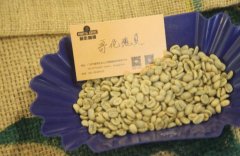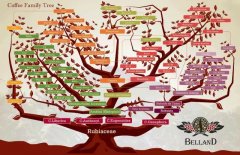The Development and Flavor characteristics of Arabica variant Coffee Bean what is the New World of Elephant Bean?
In addition to Central American and Ethiopian geisha coffee, seven Arabica intraspecific mixed bean species are also introduced. Do you know what a hybrid coffee bean is? In fact, it is very simple that Arabica and Arabica are natural hybrids of different varieties under Arabica. Arabica takes the self-pollination of the same plant as the norm, and the Haohua pollination of the same plant is abnormal, but it does not mean that it is impossible to carry out pollination. "it is just that the probability of success is low. It has been found that Rabica means pollination of the same species, such as Rabica and Rabica. Often because of the irritation of the flowers, it is easy to produce many defective fruits. As for the pollination of different varieties of flowers, that is, internal hybrids, such as Sabica and bourbon, the chances of success will be lower than the former, but over the past thousands of years, Arabica has produced many new varieties of internal hybrids as follows:

Huang Bourbon:
In 1930, Brazil found a natural mixed race of bourbon and carotene, which were naturally mixed in Brazil in 1930. After being bred by the Agricultural Research Institute in Campique, 1952 of them were distributed to farmers for planting. Bourbon seems to be more responsive to Brazilian soil and weather than bourbon, and its fruit yield is 40% more than that of bourbon, and its sweet and sour taste is also lower than that of bourbon. It is a kind of Brazilian fire in recent years, almost including the top five of Brazil's annual "extraordinary Cup" and has become a synonym for Brazilian boutique beans. It should be noted, however, that Bourbon, which sells soil and water to Brazil, is rarely the best in the CoE of other countries, nor has it made it into the SCAA Cup list.
New World (Mundo Novo)
In 1931, during the selection in Brazil, it was found that bourbon and polyphenols were more robust than natural hybrids (SumatraTypica x Bourbon vermelho), and the output was 30%, 70%, and 100% ~ 240% higher than that of bourbon. And the taste of coffee is not bad, the acidity is low, which brings new hope for Brazilian coffee, so it is named after the new world. Since 1950, it has replaced bourbon as the main species with the largest output in Brazil, and 40% of coffee fields in Brazil have been planted in the new world. The mixed-race product is also found in the title of the "extraordinary Cup", which is a variety with both quantity and quality. However, the cup test shows that the taste of the new world is bright, sour and sweet, which is rare except in Brazil. Brazil's famous bulk commercial bean Santos (Santos), mostly from this high product, rather than the old bourbon of the past.
Kaduai (Catuai)
In 1950, Brazil produced a dwarf coffee bar with a mixture of yellow Picadura and New World (Caturra Amarelo XMundoNovo). The tender end of the coffee is an ancient color, and the branches are very short. The fruit yield is 20% to 30% more than that of Karadu, and the fruit is resistant to cold and cold, so the fruit is not easy to be blown off. Being short and easy to harvest, it is deeply welcomed by farmers in Central and South America, and is the second largest product in Brazil. This kind of product also has the difference between the skin and the skin, generally speaking, the taste of the skin is slightly heavier than that of the dry skin. In recent years, Kadu'ai has entered a wonderful place in the "extraordinary Cup" in Central and South America.
Abominable (Acaia)
It can be regarded as an improved variety in the new world, that is, the new world and bourbon backcross (Mundo Novo x Bourbon vermelho). The beans are also bigger than those in the new world. In recent years, they have often appeared on the list of "extraordinary Cup" winners.
Pakathula (Pacamara)
From 1950 to 1960, researchers at True Vado became famous as Pacas and Elephant Bean and Maragogype) until 2004, when they first tried to sing in the "extraordinary Cup". The ever-changing fragrance and sweetness are impressed by the World Cup test, which has won the championship of the "extraordinary Cup" event for two or three years.
This bean is made from elephant beans & # 39; the number of beans is .70% ~ 80%, more than 17 eyes and more than 318 mesh is also 90%, and the proportion of small beans is as high as 12%. The average length of beans is 1.03 cm (generally called 0.80 ~-0.85 cm). The average length of beans is 0.71 cm (- about 0.60 cm to 0.65 cm), and the thickness is 0.37 cm to the east. The most important feature is that the sour taste is tricky, sometimes dry, while fruity, thick and greasy, eosinophilic, and the overall taste is similar to that of elephant beans.
Lakadura (Maracaturra)
This is an interesting combination. Elephant beans with Kaddura (Maragogype X Caturra) are made by Guardiola. This strange baby bean won the fourth place in the 2008 Guardiola "extraordinary Cup". Incidentally, the 2009 Nicaraguan "extraordinary Cup", Lakadura won the championship of Kaddura, and the taste of this new variety has been more recognized. It bears the fruit flavor like bean curd and Kadulaya sour, good consistency, floral fragrance, sweetness, and very sexy taste. This is another practical example of the emergence of mixed-blood green like beans.
Giant Lara: Capa-Kathura (Maracapacamara)
Lakapacasara is a new hybrid like Pachakara (Maragogype X Pacamara weighs 11 grams per birth). It takes only 1 to 2 cups of coffee to make a cup of coffee, and the output is very rare.

Important Notice :
前街咖啡 FrontStreet Coffee has moved to new addredd:
FrontStreet Coffee Address: 315,Donghua East Road,GuangZhou
Tel:020 38364473
- Prev

History and Flavor Characteristics of Central American and Ethiopian Summer Coffee Beans
Rose summer is a variety familiar to many coffee lovers. Both Central America and Ethiopia are planted, but do you know the difference between the summer flowers in these two regions? As a type of Arabica coffee bean, unlike the widely cultivated coffee varieties such as iron pickup and bourbon, Rosa is a native variety, that is, a descendant of wild coffee. Sometimes it is written gesha, because
- Next

Brief introduction of Arabica interspecies hybrid coffee bean flavor characteristics of new variety Ruilu 11 Carmont
What is a Cameroun hybrid coffee? What is Arabusta coffee? How did these interspecific hybrid coffee beans develop? Is there any difference between flavor and taste and traditional beans? With these questions, let's explore Arabica's interspecific hybrid series of beans. Mixed-race series: Arabica with non-Arabica and non-Arabica
Related
- Detailed explanation of Jadeite planting Land in Panamanian Jadeite Manor introduction to the grading system of Jadeite competitive bidding, Red bid, Green bid and Rose Summer
- Story of Coffee planting in Brenka region of Costa Rica Stonehenge Manor anaerobic heavy honey treatment of flavor mouth
- What's on the barrel of Blue Mountain Coffee beans?
- Can American coffee also pull flowers? How to use hot American style to pull out a good-looking pattern?
- Can you make a cold extract with coffee beans? What is the right proportion for cold-extracted coffee formula?
- Indonesian PWN Gold Mandrine Coffee Origin Features Flavor How to Chong? Mandolin coffee is American.
- A brief introduction to the flavor characteristics of Brazilian yellow bourbon coffee beans
- What is the effect of different water quality on the flavor of cold-extracted coffee? What kind of water is best for brewing coffee?
- Why do you think of Rose Summer whenever you mention Panamanian coffee?
- Introduction to the characteristics of authentic blue mountain coffee bean producing areas? What is the CIB Coffee Authority in Jamaica?

